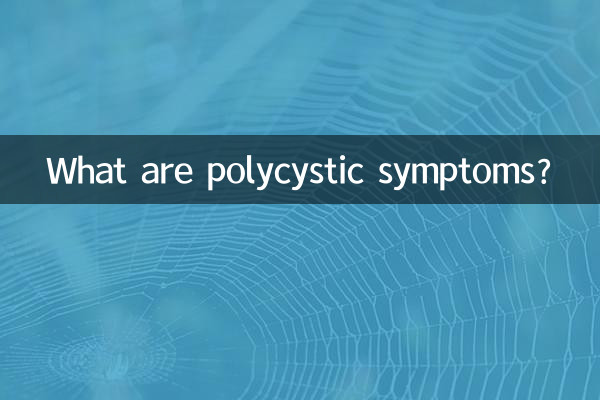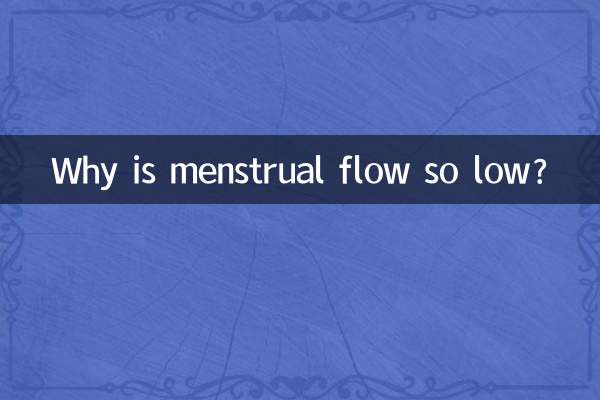What are polycystic symptoms?
In recent years, polycystic ovary syndrome (PCOS) has become one of the hot topics in the field of women's health. Many women are confused about the symptoms and effects of polycystic ovary syndrome. This article will detail the definition, symptoms, diagnosis methods and related data of polycystic ovary syndrome to help everyone better understand this disease.
1. Definition of polycystic ovary syndrome (PCOS)

Polycystic ovary syndrome is a common endocrine and metabolic disorder that mainly affects women of childbearing age. Characteristics include polycystic ovarian changes, hyperandrogenemia, and ovulatory dysfunction. The cause of PCOS is not completely clear, but it is closely related to genetics, environmental factors and insulin resistance.
2. Main symptoms of polycystic ovary syndrome
Symptoms of PCOS vary from person to person, but here are some common ones:
| Symptoms | Description |
|---|---|
| Irregular menstruation | Prolonged menstrual cycle (more than 35 days), amenorrhea or light menstrual flow |
| hirsutism | Increased hair on the face, chest, abdomen and other parts of the body |
| Acne | Stubborn acne on face, back, and chest |
| Obesity | Weight gain, especially abdominal obesity |
| Infertility | Difficulty conceiving due to ovulation disorder |
| acanthosis nigricans | Pigmentation and thickening in skin folds |
3. Diagnostic criteria for polycystic ovary syndrome
According to international standards, the diagnosis of PCOS requires two of the following three items:
| diagnostic criteria | Specific content |
|---|---|
| Ovulation disorder | Oligomenorrhea or amenorrhea |
| hyperandrogenemia | Clinical or biochemical manifestations (eg, hirsutism, acne, alopecia) |
| polycystic ovarian changes | Ultrasound shows an increase in ovarian volume or the number of follicles is ≥12 (diameter 2-9mm) |
4. Epidemiological data of polycystic ovary syndrome
Here are the epidemiological statistics about PCOS:
| Statistics Project | data |
|---|---|
| Prevalence among women of childbearing age | 5%-10% |
| Proportion of PCOS among infertile patients | About 30%-40% |
| Proportion of obese patients | 40%-80% |
| type 2 diabetes risk | 3-7 times higher than average women |
5. Treatment and management of polycystic ovary syndrome
The treatment of PCOS requires a personalized plan based on the specific situation of the patient, which mainly includes the following aspects:
1.lifestyle intervention: Weight control, balanced diet, and regular exercise are basic treatments.
2.drug treatment: Including oral contraceptives to regulate menstruation, insulin sensitizers to improve metabolism, ovulation induction drugs to help pregnancy, etc.
3.psychological support: PCOS patients are often accompanied by anxiety and depression, so psychological counseling is very important.
4.long term management: Regularly monitor metabolic indicators such as blood sugar and blood lipids to prevent long-term complications.
6. Common misunderstandings about polycystic ovary syndrome
1.Misunderstanding 1: Polycystic ovaries will definitely lead to infertility. In fact, with standardized treatment, many patients can successfully become pregnant.
2.Misunderstanding 2: Only obese women get PCOS. In fact, about 20% of PCOS patients have normal weight.
3.Misunderstanding 3: PCOS is only a gynecological problem. In fact, it involves multiple systems such as endocrine and metabolism.
7. Summary
Polycystic ovary syndrome is a complex disease that requires collaborative multidisciplinary management. Understanding its symptoms and diagnostic criteria can help with early detection and treatment. Although PCOS currently cannot be cured, through standardized treatment and lifestyle adjustments, patients can control symptoms, prevent complications, and improve quality of life. If you suspect that you may have PCOS, it is recommended to seek medical help promptly and seek professional help.

check the details

check the details